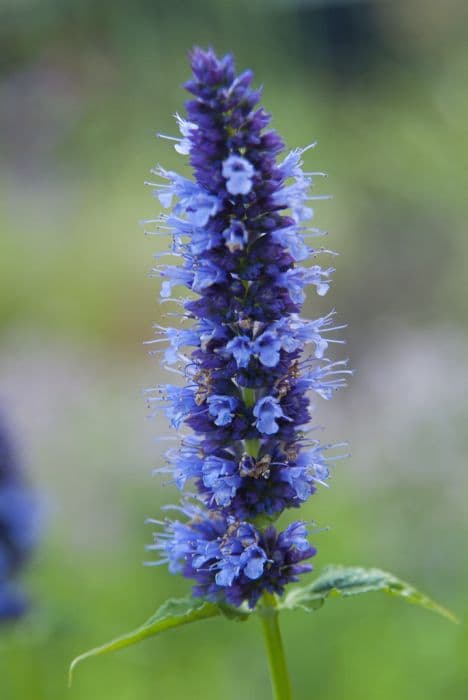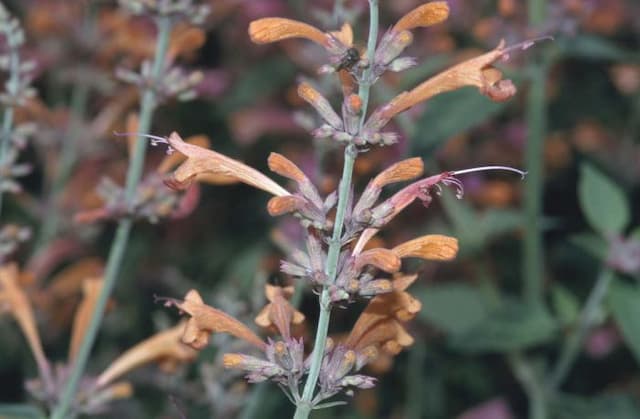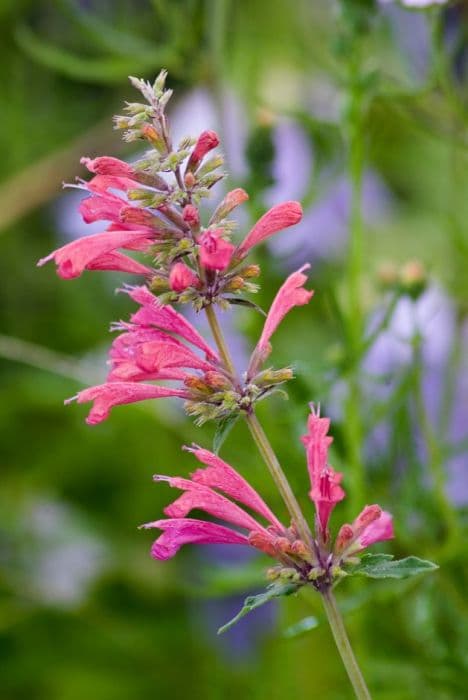Bugleweed Ajuga Sugar Plum = 'Binsugplu' (PBR) (v)
![bugle [Sugar Plum]](/_next/image?url=https%3A%2F%2Fplants-admin.emdemapps.com%2Fimages%2Fplants%2F%2Fimages%2F604b597956a55.png&w=3840&q=75)
ABOUT
Ajuga Sugar Plum, often known as Bugleweed, is a perennial with a striking appearance. This cultivar is admired for its decorative foliage and flowers. The leaves of Ajuga Sugar Plum are a mesmerizing blend of deep purple to bronzy plum tones, providing a colorful ground cover throughout the growing season. The texture of the leaves can be described as somewhat crinkled, adding a tactile aspect to the plant's overall allure. During its blooming period, Bugleweed produces spikes of vibrant purplish-pink flowers. These blossoms rise above the foliage on short stalks, creating an eye-catching contrast against the dark leaves. The flowers themselves are tubular, attracting bees and butterflies to the garden. Overall, the appearance of Ajuga Sugar Plum is lush and spreading, creating a dense mat that can add a dramatic flair to garden beds and landscapes through its intense color and unique charm.
About this plant
 Names
NamesFamily
Lamiaceae
Synonyms
Bugleweed, Carpet Bugle, Carpetweed
Common names
Ajuga 'Binsugplu'
 Toxicity
ToxicityTo humans
The Ajuga, also known as Bugleweed, is not commonly known to be toxic to humans. However, as with many plants, consuming it may cause some individuals to experience adverse reactions due to allergies or sensitivities. It is not typically associated with severe poisoning or life-threatening symptoms when ingested in small quantities, but if a large amount is consumed, or if someone has a particular sensitivity, symptoms could include stomach discomfort, nausea, vomiting, or diarrhea. It is always advisable to avoid eating ornamental plants due to the potential for unexpected reactions and the lack of information about their edibility and effects on humans.
To pets
The Ajuga, commonly known as Bugleweed, is not typically toxic to pets such as dogs and cats. There is no well-documented evidence of severe toxicity in pets from ingesting this plant. However, it is generally advised to prevent pets from consuming non-food plants, as individual pets may have sensitivities or reactions to plants. If a pet were to ingest a large amount of Bugleweed, they might experience mild gastrointestinal upset, including symptoms like vomiting or diarrhea. If you suspect your pet has consumed a significant amount of Bugleweed and is showing symptoms, it is best to consult with a veterinarian.
 Characteristics
CharacteristicsLife cycle
Perennials
Foliage type
Evergreen
Color of leaves
Mixed
Flower color
Blue
Height
6 inches (15 cm)
Spread
18 inches (45 cm)
Plant type
Herb
Hardiness zones
5
Native area
Caucasus
Benefits
 General Benefits
General Benefits- Attracts Pollinators: Ajuga Sugar Plum is known for its flowers that attract bees and butterflies, which are essential for pollination and maintaining healthy ecosystems.
- Low Maintenance: Once established, this plant requires minimal care, making it ideal for gardeners who desire a beautiful garden without extensive upkeep.
- Drought Tolerant: It can withstand periods of dryness once it matures, reducing the need for constant watering and suiting xeriscaping needs.
- Ground Cover: The plant spreads readily, providing excellent ground cover that suppresses weeds and reduces soil erosion.
- Aesthetic Appeal: With its deep burgundy foliage and vibrant purple flowers, it adds stunning color contrast and visual interest to garden landscapes.
- Hardy Nature: Ajuga Sugar Plum is known for its hardiness, allowing it to thrive in a range of conditions and climates.
- Fast Growing: It establishes quickly, providing rapid coverage and filling in bare spots in the garden with its lush foliage.
 Medical Properties
Medical PropertiesThis plant is not used for medical purposes.
 Air-purifying Qualities
Air-purifying QualitiesThis plant is not specifically known for air purifying qualities.
 Other Uses
Other Uses- Ajuga can be used as a natural fabric dye, providing a range of colors from greens to browns depending on the mordant used.
- The dense mat of Ajuga can be used for erosion control on slopes, as its root system helps to stabilize the soil.
- Ajuga's vibrant flowers can be used in pressed flower crafts, adding color and variety to artworks and handmade cards.
- In a wildlife garden, Ajuga can act as ground cover that provides hiding spots and habitat for small creatures and insects.
- Ajuga can be planted in between pavers or stepping stones, as it tolerates light foot traffic and softens the look of hardscapes.
- The leaves of Ajuga can be used in compost as a green layer, contributing nitrogen to the composting process.
- Dense Ajuga patches can be used to outcompete and suppress the growth of unwanted weeds in garden beds.
- During festive seasons, Ajuga flowers can be used as a natural confetti, biodegrading and adding nutrients to the soil instead of polluting it like synthetic confetti.
- In a sensory garden, Ajuga provides texture and color contrast, and can be used to stimulate sense of touch and sight.
- Ajuga can be used as a living mulch, keeping the soil moist and cool while also adding visual interest to the garden.
Interesting Facts
 Feng Shui
Feng ShuiThe plant Ajuga is not used in Feng Shui practice.
 Zodiac Sign Compitability
Zodiac Sign CompitabilityThe plant Ajuga is not used in astrology practice.
 Plant Symbolism
Plant Symbolism- Vigor: Ajuga, also commonly known as Bugleweed, is known for its vigorous growth habit, often symbolizing persistence and determination.
- Protection: Historically, Bugleweed was thought to ward off evil, carrying a protective symbolism.
- Healing: With medicinal uses in traditional healing practices, Bugleweed may represent physical or emotional healing.
- Harmony: Bugleweed's ability to create a dense carpet of foliage can stand for harmony and grounding.
 Water
WaterBugleweed, commonly known as Ajuga, should be watered deeply once or twice a week, depending on the weather conditions. When watering, aim for about 1 inch of water per week, including rainfall. In drier and hotter periods, increase watering frequency to ensure the soil remains moist but not saturated. During winter or in cooler climates, reduce watering to prevent root rot. Always check the soil moisture before watering to avoid overwatering, as Ajuga prefers well-drained soil and does not do well with constant wet feet.
 Light
LightBugleweed thrives in partial shade to full sun. The ideal spot for Ajuga is an area where it receives morning sun and afternoon shade, particularly in hotter climates, to prevent scorching of the foliage. However, it is also adaptable to full sun conditions provided it gets enough moisture.
 Temperature
TemperatureBugleweed is hardy and can tolerate a wide temperature range, surviving in zones often associated with a minimum temperature of around -20°F and a maximum temperature of 90°F. The ideal temperature range for thriving Bugleweed is between 60°F and 75°F, as it promotes vigorous growth and good foliage color.
 Pruning
PruningPruning Bugleweed is generally done to maintain its appearance and remove any damaged or diseased foliage. It should be pruned in early spring or after flowering to encourage denser growth. Pruning is not often required but doing so annually can help prevent it from becoming too invasive in the garden, ensuring it keeps to the desired space.
 Cleaning
CleaningAs needed
 Soil
SoilAjuga, commonly known as Bugleweed, thrives best in well-drained soil enriched with organic matter, maintaining a slightly acidic to neutral pH of 6.5 to 7.0. A good mix for Ajuga ‘Sugar Plum’ would be garden soil, compost, and a bit of sand or perlite for improved drainage.
 Repotting
RepottingAjuga ‘Sugar Plum’ generally does not require frequent repotting as it is a ground cover that spreads through stolons. Repotting can be done every 2-3 years to refresh the soil or manage its spread.
 Humidity & Misting
Humidity & MistingAjuga ‘Sugar Plum’ is adaptable to a range of humidity levels but prefers average to high humidity. It is resilient and can tolerate the humidity levels typically found in most garden environments.
 Suitable locations
Suitable locationsIndoor
Place in bright, indirect light and avoid overwatering.
Outdoor
Plant in partial shade, moist soil, and space 15-18 inches apart.
Hardiness zone
4-9 USDA
 Life cycle
Life cycleAjuga Sugar Plum, commonly known as Bugleweed, begins its life cycle as a seed which germinates in early spring under favorable conditions of moisture and temperature. After germination, it develops root systems and begins to grow low to the ground, forming a mat-like ground cover with its dense, rosette-forming foliage. During late spring to early summer, Bugleweed produces spikes of deep purple flowers that attract pollinators and subsequently may produce seeds. Throughout the growing season, it spreads via stolons, horizontal stems that allow it to propagate vegetatively and expand its coverage area. As a perennial, it survives winter by dying back to the crown, with the roots remaining dormant until the next growing season. Each spring, Ajuga Sugar Plum resumes growth from the crown, repeating its life cycle.
 Propogation
PropogationPropogation time
Spring to Summer
Ajuga Sugar Plum, commonly known as Bugleweed, is often propagated through division, which is the most popular method. The best time for this is either in the spring or in the early fall. To propagate by division, gardeners will carefully dig up an established clump of Bugleweed and gently tease apart the root mass into smaller sections, making sure each section has a healthy portion of roots and some top growth. These divisions can then be replanted in a prepared area of the garden that receives partial to full shade and has well-draining soil. They should be spaced about 8 to 12 inches apart (20 to 30 centimeters) to allow for spreading and proper air circulation. Regular watering after planting will help the divisions establish more quickly in their new locations.






![Bugle [Princess Nadia]](/_next/image?url=https%3A%2F%2Fplants-admin.emdemapps.com%2Fimages%2Fplants%2F%2Fimages%2F604b5806e268c.png&w=640&q=75)


